No matter what you may have heard, email marketing is not dead.
In fact, it’s quite the opposite.
It’s more alive than ever, as email has been proven time and again to be one of the most successful channels to reach customers and get them to buy from you.
That’s why it has an ROI of $44 for every single dollar that online retailers spend.
Nothing out there can beat that. In fact, the median ROI for ecommerce email marketing is more than 4x higher than that of social media:
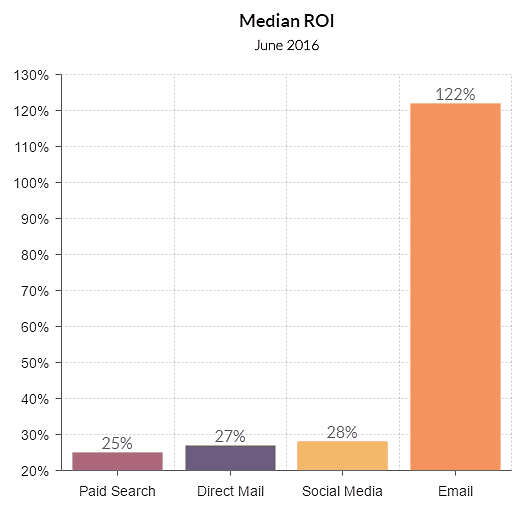
But, as anyone with an inbox has probably discovered: there’s a lot of competition when it comes to emails.
Every company is sending emails regularly, some many times a day, and it can be difficult to be successful in email marketing when competition is so high.
Right?
Well, what if I told you there’s a proven, foolproof way in which you can succeed in email marketing?
Email marketing that leads to industry-leading open and click-through rates, guaranteed conversions (sales), and reduced unsubscribed for each email marketing campaign that you send?
Sound too good to believe?
The Beginner’s Guide To Ecommerce Email Marketing
That’s what I’ll be showing you today, to take you from beginner to pro email marketing expert so you can start sending successful digital marketing campaigns in no time.
Email marketing best practices include:
- getting subscribers by using proper list-building techniques
- using smart segmentation to send different messages to different groups
- using marketing automation to automatically send out messages based on triggers
- creating high-converting emails by using good design choices
But let’s be clear here:
By successful email marketing, I mean you’ve found the right steps to take to ensure you’re bringing the right quality (content, promotions, product recommendations) to the right people at the right time.
So not only will you have success by having more sales at the end of the day, but your loyal customers will be happier with your great products.
Luckily, there are lots of great choices now when it comes to email marketing, and they’re pretty great at guiding new (or advanced) marketers through their app to optimize their campaigns.
The email marketing software includes MailChimp, Klaviyo, Omnisend, and many others.
With a great set of standard features, such email templates, as drag-and-drop newsletter builders, segmentation, automation, and even retargeting for your advertising, the most important part for you is to have a strong email marketing strategy to begin with.
Email List Building Tactics

You’ve probably heard the stats that about 97% of the people who visit your ecommerce site end up abandoning without buying anything.
In fact, for some industries, this 3% conversion rate is seen as a great success.
However, for new or growing ecommerce stores, it’s important that you get great conversions, which means you can’t just depend on traffic alone.
Instead of showing your store to your visitor and then never seeing 97% of them, why not grab their email addresses so you can give yourself a second, third, fourth and more chances?
That’s the power of email list-building: to allow you ample chances to convert subscribers into repeat customers.
To be more specific, there are 5 great advantages to converting visitors into subscribers:
- identify the visitor (you can now view them as a lead)
- directly market to leads via email marketing
- automatically triggered email campaigns
- fuel Facebook ad campaigns (custom audiences and lookalike audiences)
- trigger cart abandonment campaigns (which require a visitor’s email address)
So let’s look at how you can start collecting your visitors’ email addresses.
#1 Collect emails with popups
When using popups, it’s important to remember that you need to offer something valuable in order to get something valuable (visitor’s email address).
What you can offer includes valuable content (like an ebook), free shipping, or a percentage or dollar discount on their first purchase.
With this in mind, there are 3 important aspects of a high-converting opt-in form or popup:
- an appealing image
- an eye-catching headline, such as the simple “Wait!” or “Don’t leave without your gift!”
- an interesting offer (the ebook, discount, or free shipping we mentioned)
There are many different types of popups that can be used to collect email addresses. However, many people are aware of one type of them, which can get pretty annoying: immediate popups.
These are the popups that show up immediately when a visitor has landed on your store. They aren’t based on user behavior, and therefore can’t be set for better timing.
At Omnisend, we’ve seen that the exit-intent popup has the best results, both in terms of signups as well as user experience.
Here’s an example of a popup that has a great image, good copy, and an appealing offer:
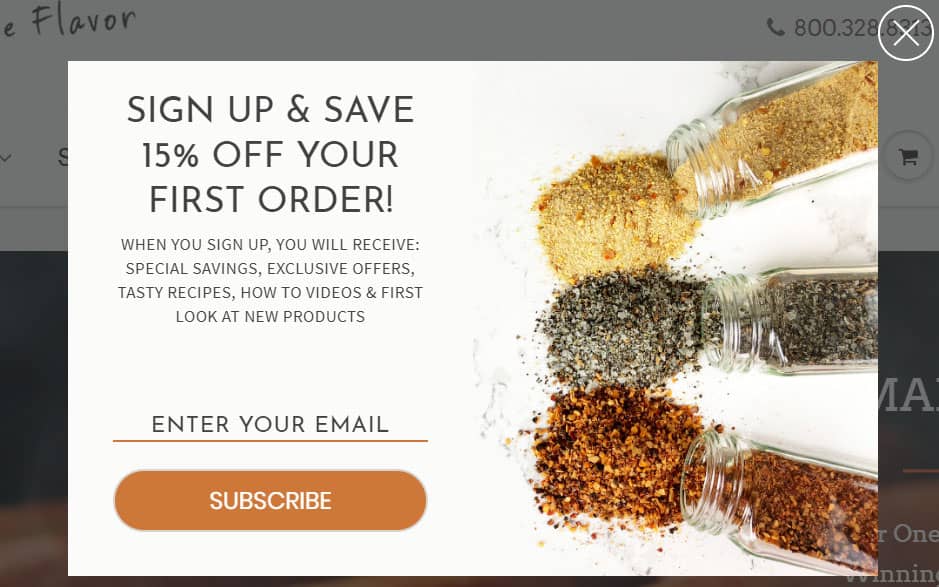
That’s because the exit-intent popup only appears when a visitor is getting ready to leave your store, by moving their mouse pointer up to close the tab or enter a new URL.
Exit-intent popups have high conversion rates, getting up to 35% of visitors to sign up.
The two other types of popups are:
- delayed popups: set the popup to only appear after a certain time or after a certain amount of clicks
- passive signup form: an always-visible widget that sticks at the bottom of the page. Users click on it to show the popup
#2 Use interactive email signup forms
Another great option for collecting email subscribers is by using an interactive, gamified signup form.
This can be seen with the ecommerce apps like Spin a Sale, Wheelio, and of course Omnisend’s own Wheel of Fortune:
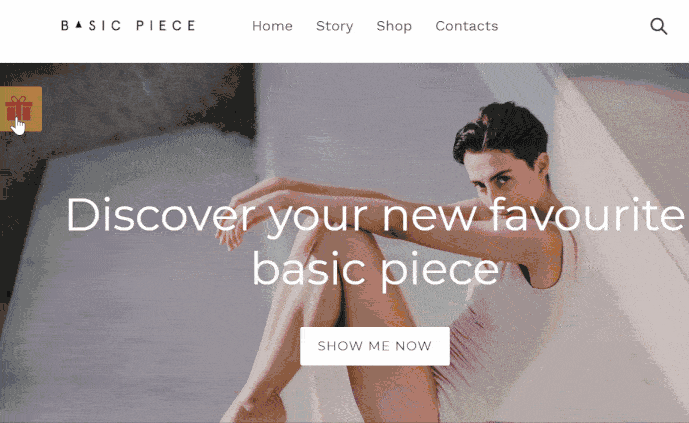
This makes it fun for your visitors to enter their email address.
And, best of all, they get a nice discount or prize immediately after spinning.
#3 Keep an eye on your CAC
It’s important, while you’re building your list and getting more high-value traffic to your store, to keep an eye on your Customer Acquisition Cost (CAC).
The CAC is, as the name suggests, the pricing and costs associated with acquiring new customers. For example, if in one month you spend $1000 on advertising and get 200 customers, then your CAC would be $5.
However, it’s important to note that the CAC by itself isn’t particularly helpful without looking at average order values (AOV) and your customer lifetime value (CLV).
If the average order is only $6, then a CAC of $5 would be quite ineffective. However, if your average orders are around $20, then that’s pretty good.
Similarly, see what your CLV is (you can find loads of CLV calculators by searching online). If it costs you $5 to acquire a customer and your AOV is just $6, it can seem quite bad.
But…if your existing customers buy their products on a cycle (for example, subscription or cyclical products like pet food or shampoo), then the $5 CAC is justifiable, seeing as in one year you can have $72 in orders from a $5 CAC.
So when you’re sending traffic to your store and busy building your lists, always keep an eye on your CAC to make sure your ecommerce email marketing strategy is paying off.
Email Marketing Segmentation

Getting subscribers is great, and if you’ve followed my advice from the above section, you’ll now have a growing audience to work with.
However, don’t make the same mistake that a lot of ecommerce marketers are making:
Sending the same message to all subscribers.
No.
If you’re selling phone cases, there’s a difference in age, gender, and behavior between the grandmother that bought the cute kitten phone case, versus the teenager that bought the sci-fi themed case.
Why treat them the same?
This is where segmentation comes from.
Segmentation is the ability of your email marketing platform the cut and slice your subscribers into as many different segments as you’d like.
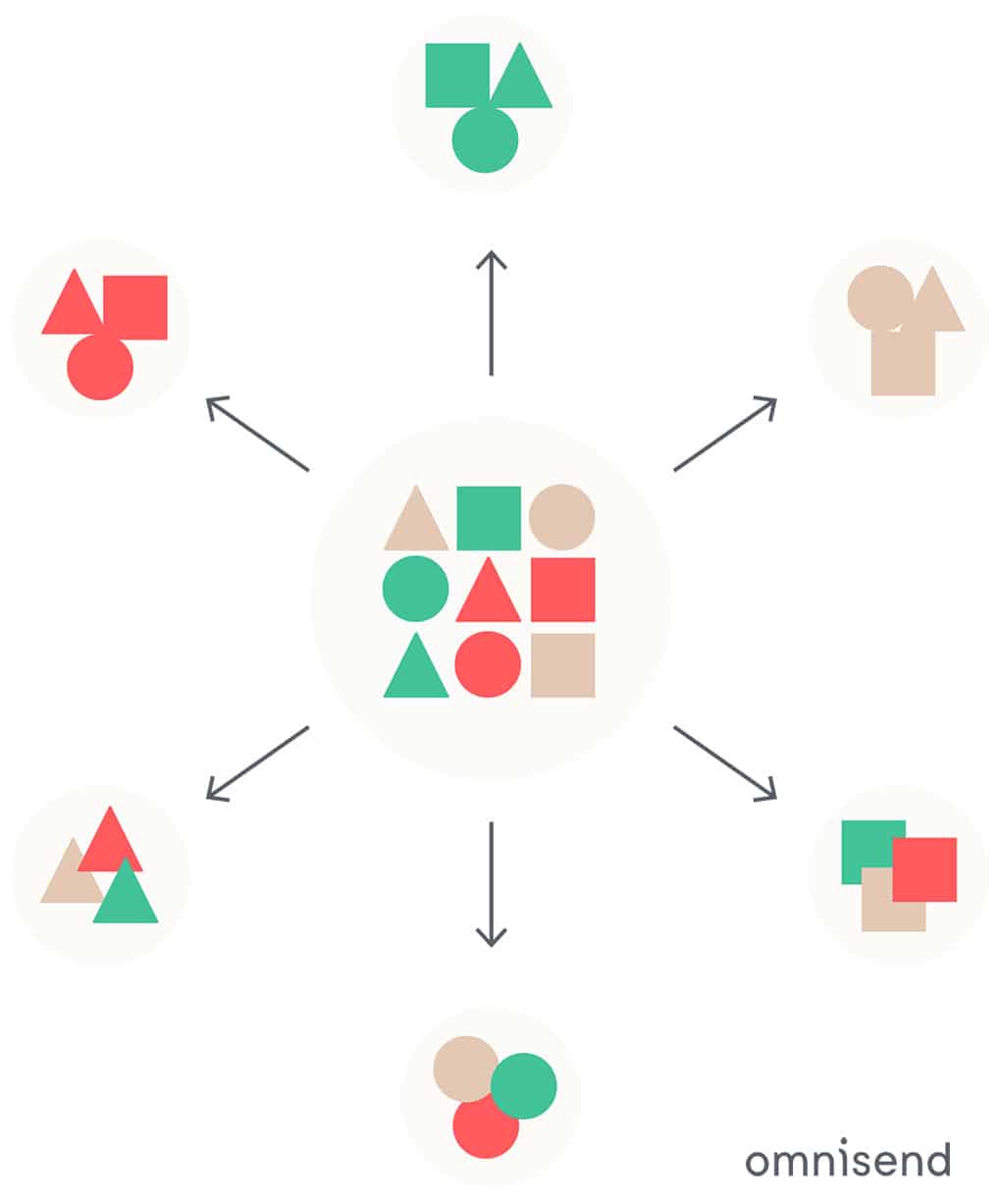
You can place them into static segments, such as city, gender, etc. Or you can place them into dynamic segments, such as “Purchased within the last 30 days” or “Hasn’t opened an email in the last 60 days.”
In fact, you can get pretty specific with your segmentation. Here, I’ve decided to create a segment of customers who’ve spent at least $50 on average since the beginning of the year:
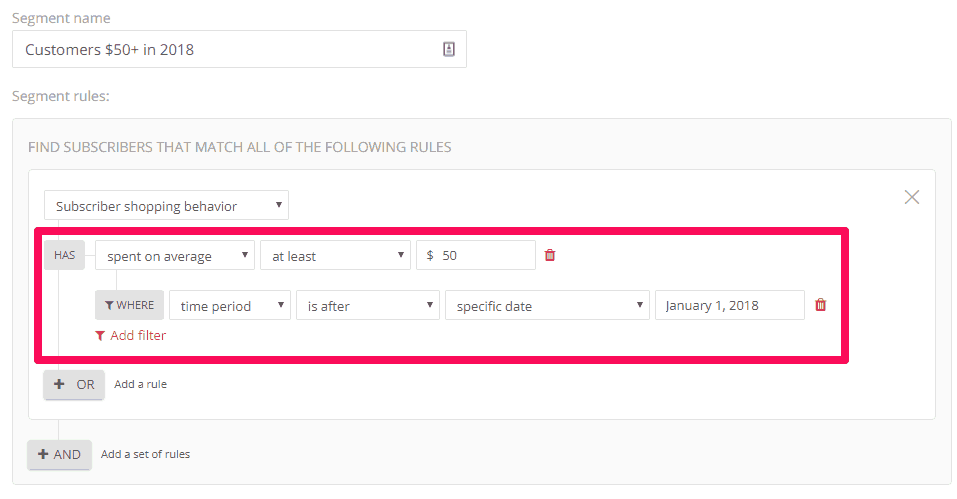
#1 How to get started with customer segmentation
When it comes to segmentation, get as simple or advanced as you think you need for better conversions for your ecommerce email marketing campaigns.
Here are some important questions to ask yourself when segmenting your subscribers:
- Have they bought from you, or are they still shopping?
- Have they abandoned carts?
- Have they interacted with your newsletters?
- Did they buy anything within the last 30, 60, or 90 days?
- Did they buy from you during a special sale (such as Black Friday, Christmas, etc.)?
- Is the demographic data (age, gender, location) important for better sales?
- How did you get their email address (purchase, popups, Wheel of Fortune, Facebook giveaway)?
By answering these questions, you can set up different segments and send them relevant content.
For example, if I have 100 customers who bought from me only one time, during Black Friday, and regularly open my newsletters, I can send them an email with the subject line, “Don’t wait til Black Friday to catch these amazing deals!”
Segmentation allows you to send targeted emails, with the high probability that subscribers will not only open them, but also click on them and buy from you.
#2 How segmentation boosts loyalty (and why that’s so crucial)
When we’re talking about customer loyalty, we’re pretty much talking about helping guide someone through their customer journey.

We want them to go from awareness to loyalty, and then further on to advocacy and referral. That means that not only do they enjoy the brand (loyalty) so that they’ll buy more from you for a longer period of time, but they’ll love it so much that they want to spread the word about it.
That—word of mouth—is the holy grail of all marketing, and luckily for you, you can achieve that with email marketing.
We can add it to an entire category called “loyalty marketing,” which is specifically for those contacts that have already bought from you.
You want to keep them active so they can complete their customer journey. Think of it in two ways:
- non-promotional, brand-building content
- promotional content for repeat buyers
Communicate in order to build your brand
One way to do build loyalty is to think of providing customers with quality content that is not promotional. Let’s say you segment your customers into two groups: buyers and non-buyers.
For non-buyers, you can use the regular promotions, sales, etc., with a variety of topics. But for buyers, seeing as they’ve already purchased from you, consider sending them valuable content that they would enjoy and that continues to build up your brand.
Remember, branding is the thing that separates flash-in-the-pan, short-term stores from sustainable, long-term businesses.
Talk about your sourcing, your social media reviews, your employees and partners. Talk about your mission, beyond just business. Do you believe in saving the environment–trees, ocean, etc.–or giving back to the poor? Do you donate to charity?
Enact loyalty programs
Beyond that, think of promotional content that would be perfect for repeat buyers: this can be shipping after a certain amount spent, subscription services, and, most popularly, loyalty programs.
If you can enact a loyalty point system, then if your customers earn, let’s say, 50 points in one month, they’ll get a free gift, or 100 points within 3 months, another gift, etc.
You can set up different kinds of points that will suit your business. And, luckily for you, there are lots of apps out there that can help you with this, such as Smile.io, Bold’s Loyalty Points, ReferralCandy and much more.
With integrated loyalty apps and your favorite email marketing program, you can even send out automated weekly email reminders of the accumulated points (and hints about what they can already or almost buy with that).
Email Marketing Automation

The next step, after you’ve gathered your subscribers and started slicing and dicing them into relevant segments, is to set up your email automation workflows.
Automation workflows are very important for ensuring that your customers get the right message at the right time.
Instead of manually sending out newsletter campaigns, you can make sure that your subscribers get a specific email at a specific time.
Some examples of automated types of emails include:
- cart abandonment emails
- welcome emails
- birthday emails
- new customer email
- order confirmation emails
- post-purchase emails
- shipping confirmation emails
- customer reactivation (winback) emails
- transactional emails
These are the marketing emails that you practically cannot send manually. They are based on customer triggers, so that when a customer completes an action, they get an email.
For example, if a customer signs up to your newsletter, they get a follow-up welcome email.
If they add items to their cart and leave without buying, they get the cart abandonment email.
If they buy something from you, they get an order confirmation email, and when their order is shipped, they get the shipping confirmation email.
These may seem like standard emails, but they’re actually great for sales seeing as the open and click rates are very high, with averages around 60% for most.
Today, I want to talk about 3 specific automated workflows that will get you an amazing amount of sales with very little work.
#1 Welcome emails
First of all, I want to make clear that these are not single emails that you’re sending out to your new subscribers.
This is a series of 3 emails, based on Omnisend research. We found that with a series of welcome emails, you can get 3x higher open and click rates—as well as 5x higher revenue.
Your welcome email series should be specifically focused on creating a brand with your new subscribers.
We recommend the following workflow:
- 1st email: make sure the potential customer understands who you are, what you stand for, and how you’re different. It’s important here to make a great first impression.
- 2nd email: show your subscribers a behind-the-scenes look at how you design, source, and create your products. This will help you impress them with your quality, luxury and simplicity when it comes to your products.
- 3rd email: The last email in the brand-building series will accomplish two simple things—show happy customers and offer a discount. This is where the sales will come from.
Visually, this is what an example automation workflow looks like for the welcome series:
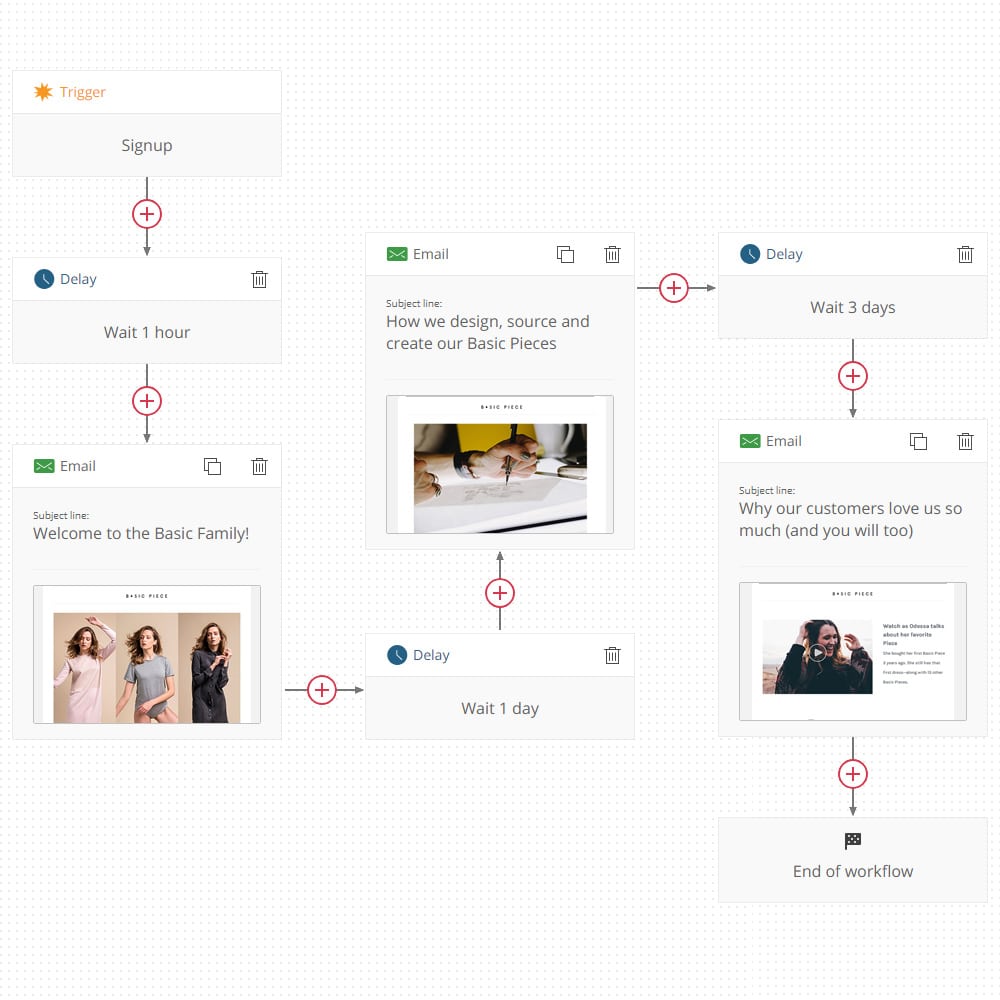
As you can see, I’ve also included a delay, ranging from 1 hour (for the first email), to 3 days (between the second and third email).
You can decide whichever works best for you.
Here you can see the exact emails I’d be sending in the workflow example:
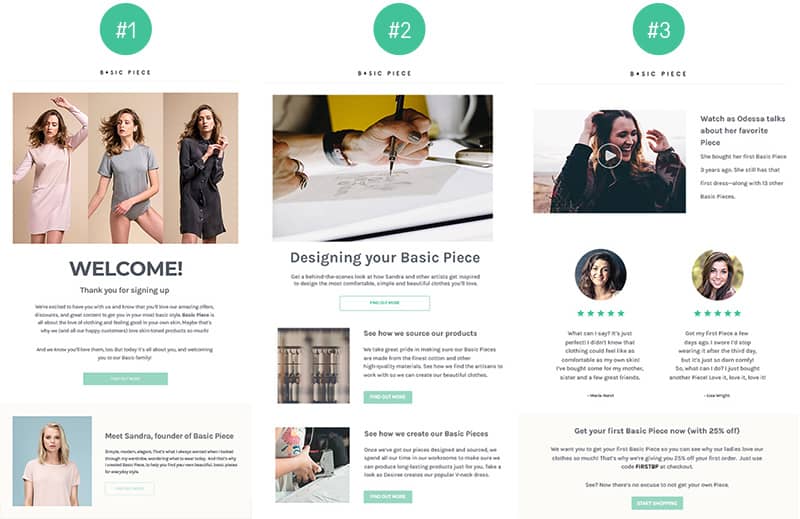
Our example welcome email automated series. Click here for the larger version.
You can do something similar with your new customer emails, seeing as welcome emails will go out to everyone.
In that case, you can offer your new customers more behind-the-scenes content, such as the sourcing (in the 2nd email above), as well as invitations to join your social communities.
#2 Birthday emails
Besides the welcome email series, you can also set up a series of birthday emails to go out to your subscribers when it’s their special day.
Research has shown that ecommerce businesses that implement this email marketing tactic get about a 45% open rate, 12% click rate and 3% conversion rate.
Of course, in order to be able to send them birthday messages, you’ll need to get their birthday info.
That’s why we recommend you ask for that information in your popups:
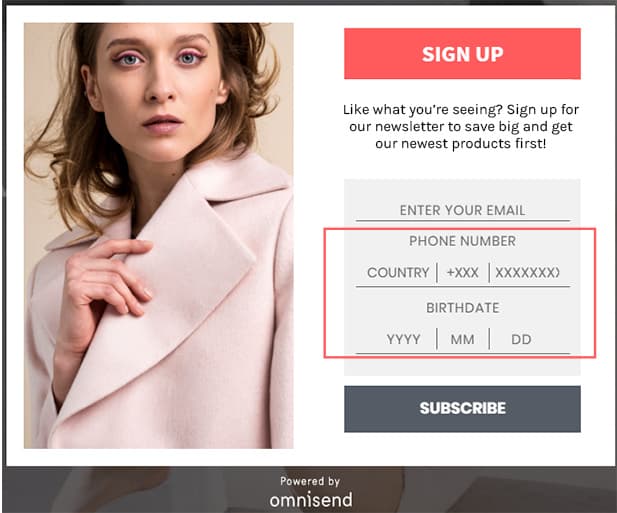
Now, as always, you can send out one email wishing your recipient a happy birthday and giving them a special gift.
However, if you really want to stand out, why not try combining a few channels? This is a bit more advanced, but here we’ll add a quick SMS/text message first, followed up by a nice email.
This is what the workflow looks like:
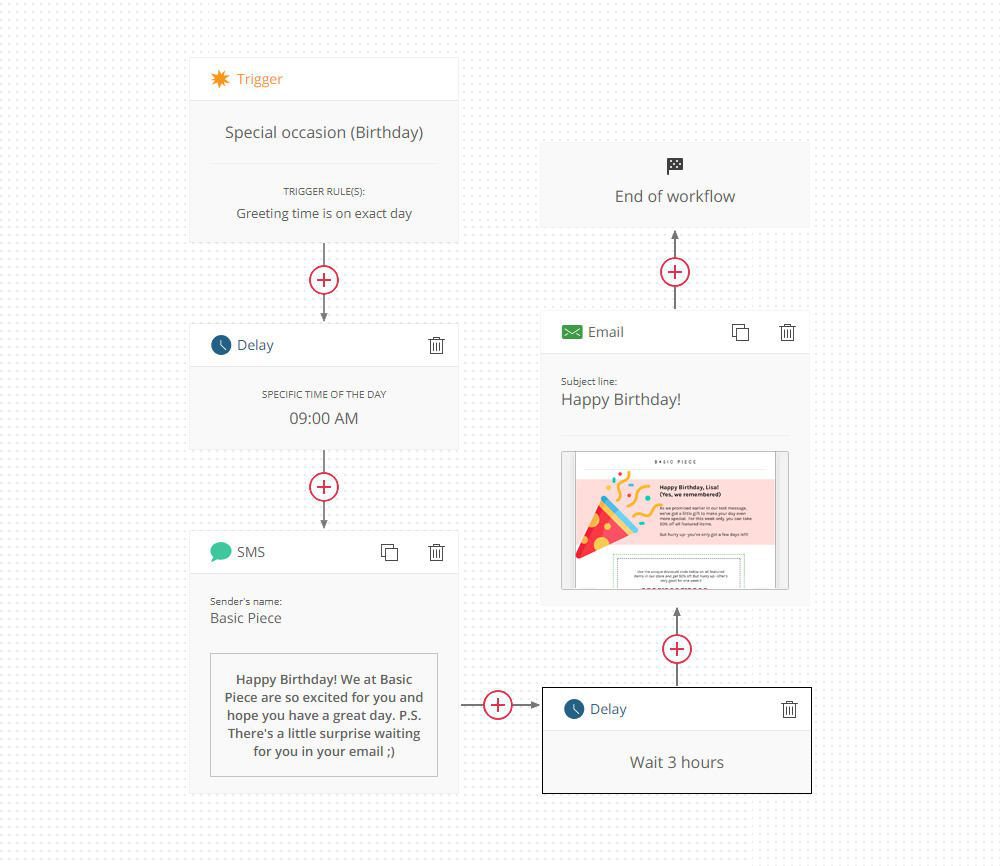
Our birthday series example involves sending a text message on the subscriber’s birthday (in the morning) wishing them a happy birthday and letting them know that a gift is waiting for them in their inbox.
Then, we set up the email to go out as the second item 3 hours later, which will include the gift—a discount, free shipping, or whatever else you think would be appropriate.
Here’s what our text message and email look like:
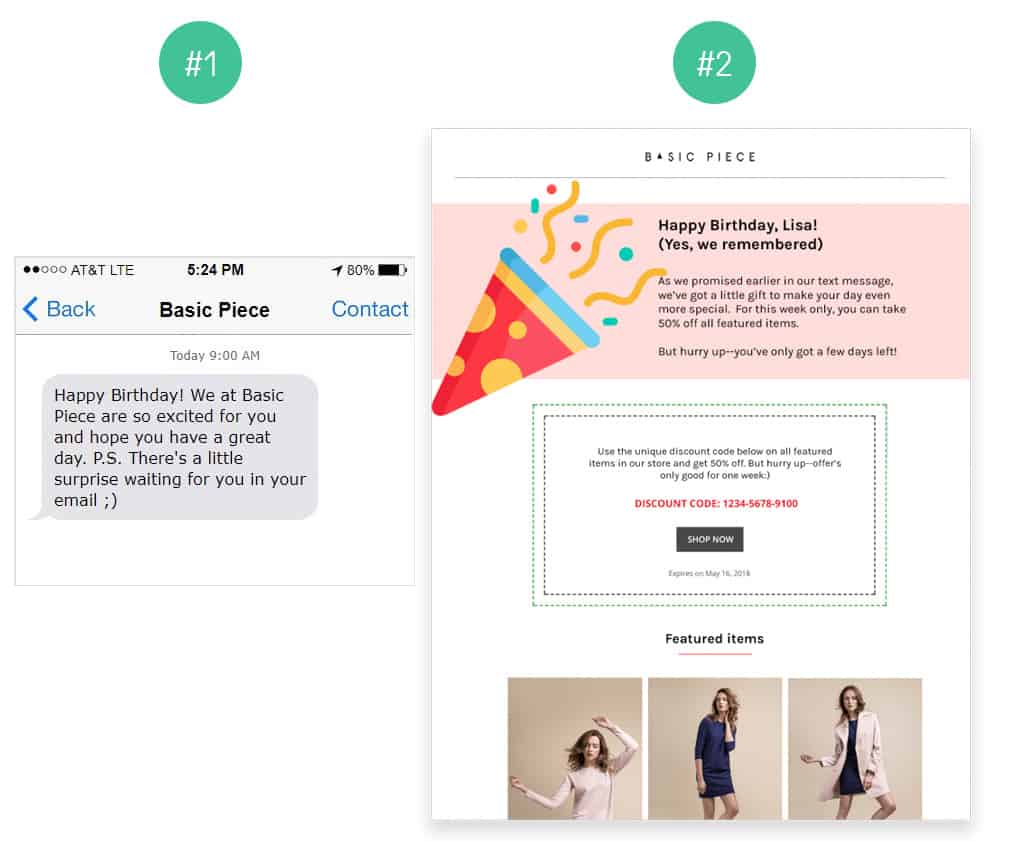
#3 Abandoned cart emails
Lastly, we have the ever popular cart abandonment emails. These are automatically sent to your known shoppers who add items to their carts but leave your site without buying anything from you.
These emails are powerful, as they can get your subscribers to buy from you while they’re still in the shopping mood.
If you send them out too late, they may no longer be interested.
It’s surprising, however, that metrics show only 20% of ecommerce marketers are sending out these all-important automated emails.
With cart abandonment emails, it’s best to be straightforward. The most important thing to include there is:
- images of the actual abandoned product(s)
- an interesting or catchy title, such as “Still shopping?” or “You left some items in your cart”
- a clear CTA button that the reader can easily click to get back to their abandoned cart
While brand-building is always important, this is the time where you show off your products and make sure your recipients get back to your store so they can complete the purchase.
Our example cart abandonment emails look like this:
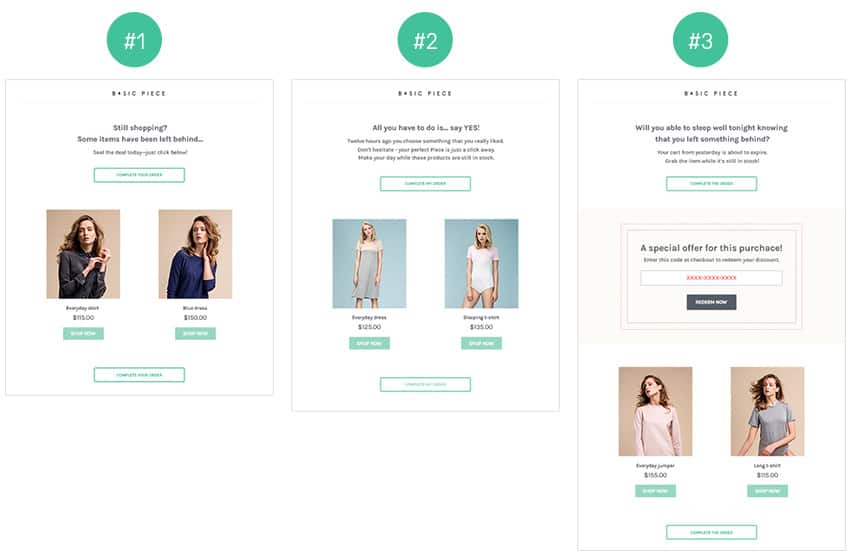
Our example cart abandonment automated series. Click here for the larger version.
As you can see, the messages are pretty straight-forward. They’re also focused on the products that are abandoned, rather than any other potentially competing images.
When creating your shopping cart abandoned emails, remember to:
- Get the timing right: it’s recommended that you send your first cart abandonment email an hour after abandonment. If using a series of abandonment emails, they should go out after 1 hour, 12 hours, and 24 hours.
- Use high-converting subject lines. These should be straight forward, such as “You left something in your cart”, “Why did you leave”, “Still shopping”, etc.
- Include images and info about the actual abandoned products. This should include the color, pattern, size, etc., so that they get a clear reminder of what they’re leaving behind.
- Add a big, easy-to-see CTA button. Don’t spend too much time on fancy, complicated copywriting. Just get straight to the point and include a big CTA with simple text, such as “Continue shopping”, “Take me back”, etc.
Email Content Strategy
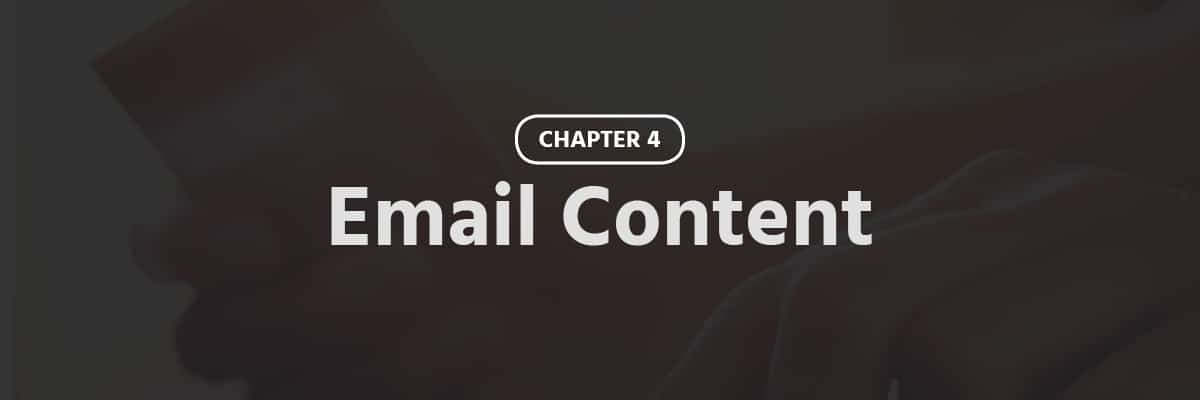
OK, now that we’ve covered getting subscribers, segmenting them, and setting up automated emails, let’s look at how you can make sure your emails have great designs that lead to great conversion rates.
When talking about the perfect email design, we’ll quickly go over:
- using the KISS principle
- showing high-quality images
- highlighting a call-to-action to guide your subscribers
#1 The KISS principle
When it comes to design, especially email design, the US Navy’s KISS principle is really applicable.
Here, KISS stands for:
Keep It Simple, Stupid!
It’s recommended that you don’t add too much stuff to your email campaigns, so that your subscribers won’t feel overwhelmed.
Here’s some quick tips:
- Use a maximum of three columns.
- Don’t use a lot of content. In the mobile version, only one column will be shown and your newsletter will appear endless.
- Don’t overreach with “super-fancy” asymmetric email newsletter designs. In most cases, they are not mobile-friendly, so only desktop users will be able to enjoy your emails.
- If your newsletter highlights different types of content, clearly define sections by using spacing and lines.
#2 Unique, relevant subject lines
Your contacts will probably get hundreds of emails every single day, and that number is increasing as more companies get started with email marketing.
This is why having compelling, unique and relevant subject lines is so crucial.
It helps you stand out among your competition, meaning you’ll get more attention from your customers. Here are some quick best practices when it comes to your subject lines:
- Personalize them: studies show that personalized subject lines get 2.6% more opens than those without personalization
- Keep it short and sweet: make sure your subject lines aren’t too long. Keep them concise, and put the most important information at the beginning (like ‘Sale’, ‘25% off’, ‘Black Friday’, etc.)
- Use compelling power words: these strong words will get noticed by your subscribers. They include: ‘Join us…’, ‘Private invite…’, ‘24 hours only…’, ‘Limited time offer…’, etc. Subject lines using urgency or exclusivity can boost open rates by up to 22%
- Avoid spam filters: Try not to use overly spammy words (even something like ‘Guaranteed’ can be tricky), and please don’t use all caps (with a thousand exclamation marks). While it’s not a guaranteed that you’ll end up in Spam, it’s very likely that you will.
- Test your subject lines: In general, you should always test everything, including your subject lines. If your email marketing has A/B testing, it’s a great time to use it to see which wording works best, or just test across multiple campaigns.
- Use your preheader: the preheader is short text (30-50 characters) that follows your subject lines. By default, it’s the first text found in your email body, but you can set your own text. Think of it as a second subject line.
#3 High-converting copy
When it comes to writing high-converting copy (that helps you sell your products), there is a wide range of what’s acceptable and what’s recommendable for ecommerce brands.
It really all depends on who your audience is (and how well you know them).
But, for the most part, write your emails in a similar way to writing a casual blog post. Keep the sentences short, logical, and to the point.
Don’t write thick, academic paragraphs that no one will be able to get through. Instead, break up ideas into separate paragraphs and, if needed, use bullet points or lists.
If you know your audience well enough, then you’ll know what kind of copy they prefer: humorous, excited (lots of exclamations marks and emojis), reserved, or even philosophical.
Nonetheless, there’s a range of conversational to formal for each of these different types of audiences, and when it comes to email content marketing, you should always try to strike a casual tone.
When writing for email, think about the absolute best squeeze, funnel, landing page, or product page you’ve ever read. Usually, it starts with a great promise or incentive, followed by a personal, relevant story, and then an explanation of that promise or pitch.
If you try the same in your emails, even adding a little bit of your personality, you’ll see great conversions.
#4 High-quality images
The quality of your images can often communicate to your subscribers the quality of your marketing efforts.
In general, you should follow these two basic steps when it comes to image quality:
- Make sure your logo is of good quality with a transparent background. If you want to look professional, you should have a good-quality company logo.
- If you use product listing, use the same size and same style of images. They cannot be blurred, too dark, or of different sizes.
#5 Call-to-actions
When designing your emails, make sure you’re guiding your recipients to one or a limited amount of actions.
You don’t just want them to open and read the emails. You want them to click on something.
Make that something a high-contrasting, large button that will be hard to miss.
Also, make sure that there aren’t a lot of these competing CTA buttons throughout your newsletter, so that your recipients won’t get confused and end up clicking on nothing.
When it comes to CTAs, there are some simple ground rules you should be following:
- Be short, active, and clear. Use language such as ‘Buy now’, ‘Pick your favorite’, ‘Visit our store’, etc. You can also consider making these in all caps.
- Use high-contrasting links or buttons. These CTAs should be obvious so that readers won’t be able to miss them. They should also be strategically placed (and leave some empty space around the button so that it stands out). If you have a longer email, duplicate the CTA at the top and bottom.
- Don’t use images as CTAs. Since some email clients tend to block images, there’s a section of your subscribers that won’t see the button at all.
- Don’t overcrowd (and confuse) with too many CTAs. Your readers will get lost and your engagement will sink.
In fact, this last point is what led online store Kali Laine to ask us for help with their conversion rates. When we looked at their emails, we saw the problem:
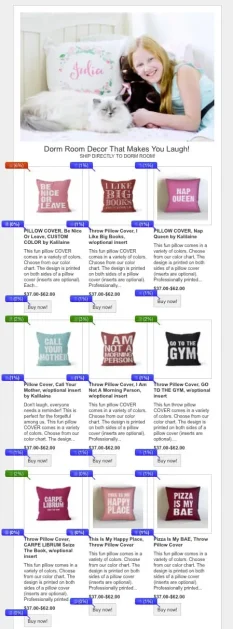
And this is only half the email. In total, there were 18 different CTAs.
We decided to redesign their emails, minimizing the CTAs and improving the design quality:

As you can see, there are now only 2 CTAs: the first under the discount code, and the second under the products.
With just these simple improvements, Kali Laine’s click rate increased by 118%
FAQs
In order to succeed with email marketing, like any type of marketing, you’ll need three things:
- proven best practices
- a solid, comprehensive strategy
- personalized email
In our article today, I gave you the best practices in four different areas.
These are what are going to help you make sure your email campaigns are a sure success—as long as you have a solid strategy to go along with it.
Here, what I mean is that you need to have a clear understanding of:
- who your audience is
- what about your products is so unique
- how you’re getting your visitors
- what steps you want your customers to follow along their journey
- how long your funnel is
These issues are larger than what I’ve presented here in this article, but when you’re able to address them properly, you’ll see great successes in not only your email marketing, but your entire marketing funnel in general.
Good luck!









